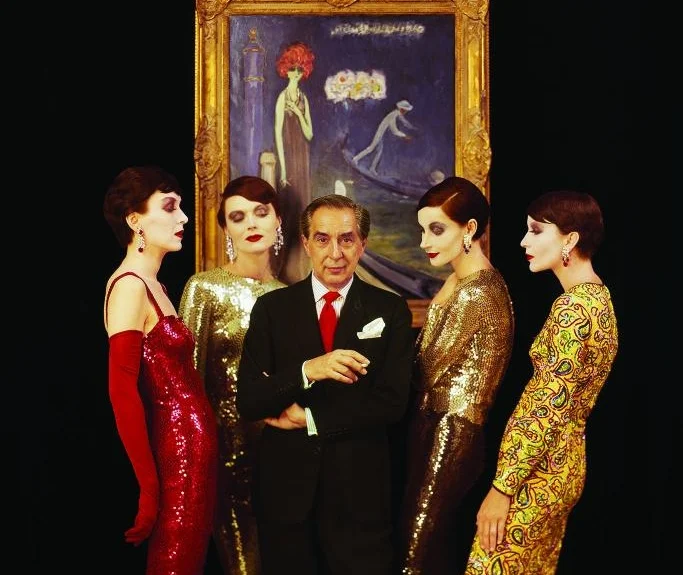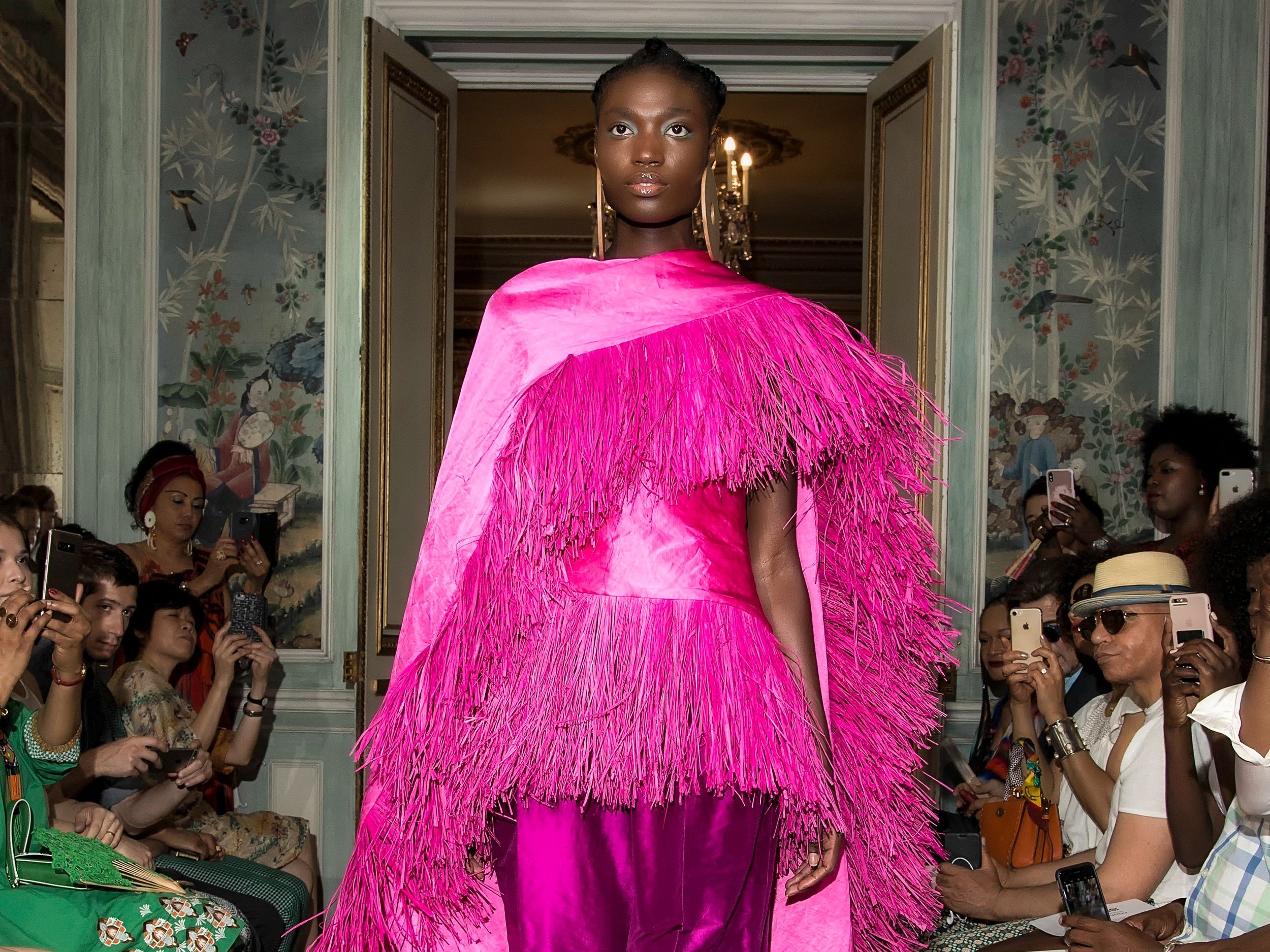9 Must-See Fashion Exhibitions in 2018

ROYAL WOMEN
February 3 – April 28, 2019
This exhibition explores the fashions adopted by successive generations of women in the Royal Family looking at the sartorial choices of Queen Alexandra, Queen Mary, Queen Elizabeth The Queen Mother, and Princess Margaret and examines how their roles influenced fashion choices of their day.
Queen Alexandra (1844‑1925) was a fashion icon and set a trend for chokers and high necklines; Queen Mary (1867‑1953) played a key steadying and reassuring influence during difficult times, and her dress styles reflected this, while Queen Elizabeth The Queen Mother (1900‑2002) favoured more dramatic eveningwear and soft-pastel-coloured daywear that flattered her diminutive height.
Exhibition highlights include Alexandra, Princess of Wales’ 1963 wedding dress; an ensemble of gold and pale green velvet worn by Queen Mary to the wedding of her granddaughter, Princess Elizabeth; and a Christian Dior ‘Rose Pompon’ strapless cream silk chiffon day dress worn by Princess Margaret in 1952 as well as a Christian Dior strapless black lace evening dress she wore in 1953.
Norell: Dean of American Fashion
February 9 – April 14, 2018
Born in 1900, Norman Norell started his career as a costume designer for Paramount Pictures in the early 1920s before transitioning to fashion design and working at Hattie Carnegie, a leading New York fashion houses in the 1930s and ‘40s, renowned for its ‘licensed’ copies of Parisian couture. In 1941, Norell started a business partnership with Anthony Traina, a manufacturer of high-quality garment. His creations soon attracted an A-list clientele including Lauren Bacall, Jacqueline Kennedy, Lena Horne, Marilyn Monroe, and Lady Bird Johnson amongst others.
With 100 pieces of clothing and other accessories, this major retrospective will trace the career of the influential designer who spearheaded the launch of luxury ready-to-wear, codifying the use of couture techniques at a ready-to-wear affordability.
The quality of his ready-made creations was so high they were often favorably compared couture designs made in Paris with trade rags nicknaming him "The American Balenciaga."
The designer was known for his love of wool jersey, which he first used on solid or color-blocked shirtdresses in the 1940s, when many designers still favored floral day dresses. Later, he paired wool jersey with fabrics like organza to make dramatic but comfortable evening clothes. His glittering “mermaid” gowns also used form-fitted knitted jersey base to embroidered sequins. In the 1960, Norell created a sensation with a culotte-skirted suit in wool flannel.
Margiela / Galliera, 1989-2009
March 3 to July 15, 2018
A major retrospective dedicated to Belgian fashion designer Martin Margiela, tracing his career from spring-summer 1989 over 20 years to 2009, when he left the maison seven years after having sold it to the OTB Group (John Galliano is currently the creative director of Maison Margiela).
After a stint as Jean Paul Gaultier’s assistant between 1984 and 1987, Margiela was known for his conceptual approach that challenge the fashion aesthetics of his time. Constructing a garment often involved deconstructing others, exposing the inside, the lining, and the unfinished parts, and revealing the different stages of manufacture: pleats, shoulder pads, patterns, bastings and all. He questioned the obsolescence of clothes with his «Artisanal» collection, created from vintage garments and recovered materials, which he transformed into unique hand-sewn pieces.
He pushed the scale of a garment to extremes, enlarging the proportions to 200% in his “Oversize Collection”, for example, or by adapting dolls’ clothes to the life-size human form in the “Barbie Collection”. He printed trompe-l’oeil photos of dresses, sweaters and coats and created a new form of “cloven” shoe inspired by traditional Japanese tabis, i.e. with the big toe separated from the others.
A cape of cockerel feathers, a pineapple fibre clutch-bag, and a dress made using recycled shoreline plastic will be some of the creations of this exhibition which aims to explore the complex relationship between fashion and nature.
Fashioned From Nature will show how designers like Christian Dior and Dries van Noten, have recurrently drawn on the beauty of nature for inspiration, but will also explore how fashion’s processes and the demand for raw materials damage the environment, featuring campaigners, protest groups and designers who have effectively highlighted this issue such as Fashion Revolution and Vivienne Westwood.
The V&A exhibition will also look at the role of design and innovation in creating more sustainable garments, showcasing the innovative work of designers like Stella McCartney and Calvin Klein. The later created a dress made of recycled plastic bottles that Emma Watson wore at the 2016 Met Gala, which will be on show.
Innovative fabrics, such as Vegea, which uses grape waste to form a leather-substitute, as well as ‘Orange Fibre derived from waste from the Italian citrus industry will also be showcased.
Heavenly Bodies: Fashion and the Catholic Imagination
May 10 - October 8, 2018
Ecclesiastical garments, in turn splendid in the use of their gold thread and sober with their use of black and white, have had an enduring influence on fashion from the creations of Cristóbal Balenciaga and John Galliano to those of Donatella Versace and more recently Guo Pei.
This thematic exhibition will feature around 50 ecclesiastical masterworks, including papal vestments and accessories on loan from the Vatican that will encourage comment on the 150 ensembles on display, primarily womenswear from the early 20th century to the present.
“Fashion and religion have long been intertwined, mutually inspiring and informing one another,” states Andrew Bolton, Curator in Charge of The Costume Institute and the exhibition. “Although this relationship has been complex and sometimes contested, it has produced some of the most inventive and innovative creations in the history of fashion.”
The exhibition will be spread over three locations, the Anna Wintour Costume Center, the medieval galleries of the Met’s Fifth Avenue site, and The Met Cloisters with religious art from The Met collection providing an interpretative context for fashion's engagement with Catholicism, hopefully in the way that the Met’s Asian galleries provided the perfect setting for the China through the Looking Glass exhibition in 2015.
The Museum's collection of religious art, in combination with the architecture of the medieval galleries and The Cloisters, will provide “the perfect context for these remarkable fashions," added Daniel H. Weiss, President and CEO of The Met.
Haute Dentelle, Museum of Lace and Fashion
June 9 - January 6, 2019
Synonymous with delicacy, the apparent fragility of the lace is an illusion: its woven texture means it cannot be unravelled. A textile of high technicality and the subject of never-ending design research among lace-makers, lace has become multi-faceted: in infinite shades, textures, finishing techniques and embroideries, it may be transparent or opaque, with floral or abstract patterns, light or three-dimensional.
Presenting more than sixty dresses from haute couture and prêt-à-porter, the exhibition will offer an insight into the contemporary uses of lace by fashion designers with exceptional pieces from thirteen fashion houses: Alberta Ferretti, Balenciaga, Chanel, Dior, Jean Paul Gaultier, Iris van Herpen, Louis Vuitton, Maison Margiela, Schiaparelli, Valentino, Viktor&Rolf, Yiqing Yin, and Zuhair Murad.
Frida Kahlo’s Wardrobe
16 June – November 4, 2018
When Frida Kahlo, the iconic Mexican artist, died in 1954 her husband, Diego Rivera, sealed her wardrobe and personal effects in the bathroom of their Mexico City home, and ordered they be kept hidden until 15 years after his death. Although he passed away soon after Kahlo in 1957, her belongings remained locked away until 2004.
The V&A will present the first exhibition of these personal artefacts and clothing outside of Mexico, pairing the items with some of her most emblematic self-portraits and curators will highlight the development of the artist’s iconic fashion style as an amalgam of traditional Mexican garments, fashion from Europe and beyond.
Kahlo’s physical disabilities are also central to understanding her sartorial choices, and the exhibition will offer fresh perspectives on Kahlo’s compelling life story through the display of orthopaedic devices and medicines. Highlights of the exhibition will include hand-painted corsets, examples of her famous Tehuana dress, and paintings such as My Dress Hangs There (1933) and The Love Embrace (1943).
Pink: The History of a Punk, Pretty, Powerful Color
FIT, New York
September 7 – January 5, 2019
The stereotype of pink-for-girls versus blue-for-boys may be ubiquitous today, but it only gained traction in the mid-twentieth century. In the eighteenth century, when Madame de Pompadour helped make pink fashionable at the French court, it was perfectly appropriate for a man to wear a pink suit, just as a woman might wear a pink dress.
This exhibition will look at the symbolism and significance of pink through time and space. While some associated the color with pretty , and romantic, others associate it with childish frivolity or flamboyant vulgarity.
In recent years, however, pink increasingly has been interpreted as cool, androgynous, and political. “Why would anyone pick blue over pink?” mused the rapper Kanye West. “Pink is obviously a better color.”
Contemporary Muslim Fashion
September 22 to January 6, 2019
In recent years, there is been increased awareness of Muslim dress codes as an important segment of the global fashion industry. This is perhaps most evident in the emergence of modest fashion weeks to promote the work of established and emerging designers who adhere to Muslim design aesthetics, as well as by the shift among both Western and non-Western designers to create styles specifically for Muslim clients.
As Islam is a multicultural faith, its practitioners’ fashion sense is shaped not only by religious principles, but also by regional customs and traditions and global fashion trends so for many Muslims, dressing in a visibly Islamic and highly fashionable style offers a way to promote a positive awareness of their culture.
Contemporary Muslim Fashion will be the first major museum exhibition to explore the complex and diverse nature of Muslim dress codes, looking at how Muslim women have become arbiters of style within and beyond their communities, and in doing so drawing attention to contemporary Muslim life.
The exhibition will include commissioned couture and high-end fashions, such as those by United Arab Emirates-based Faiza Bouguessa and Malaysian-based Blancheur, along with streetwear from the likes of Brooklyn-based Slow Factory and London-based Sarah Elenany and a range of sportswear including the burkini. One section will be dedicated to exploring various approaches to head-covering around the world, featuring different examples (hijab, burka, turban, and headwrap), as well as more recent commercial propositions, such as the sports hijab


















